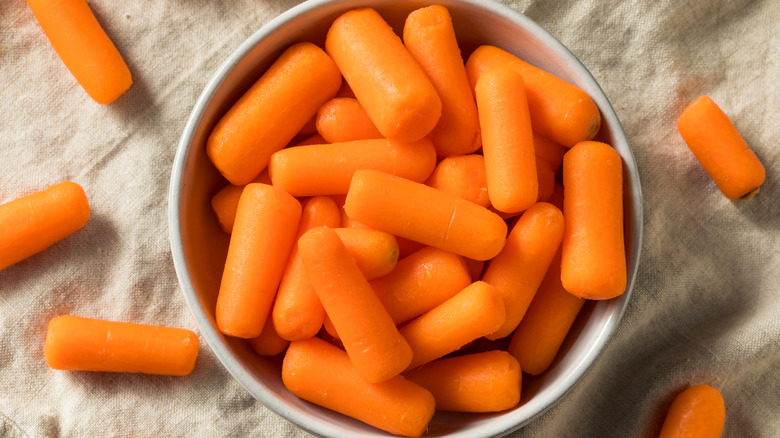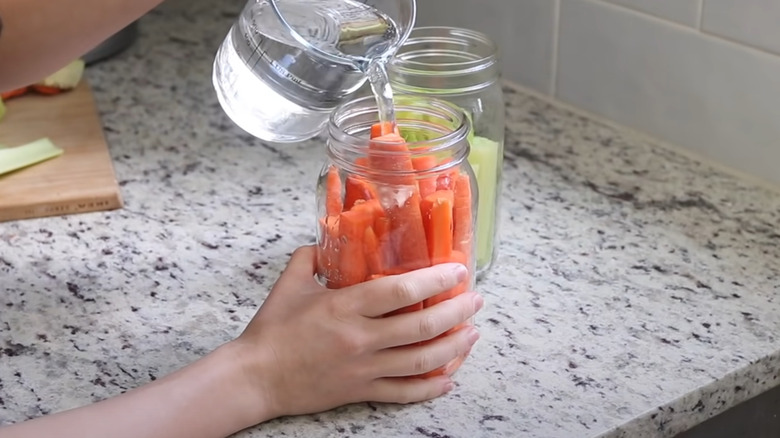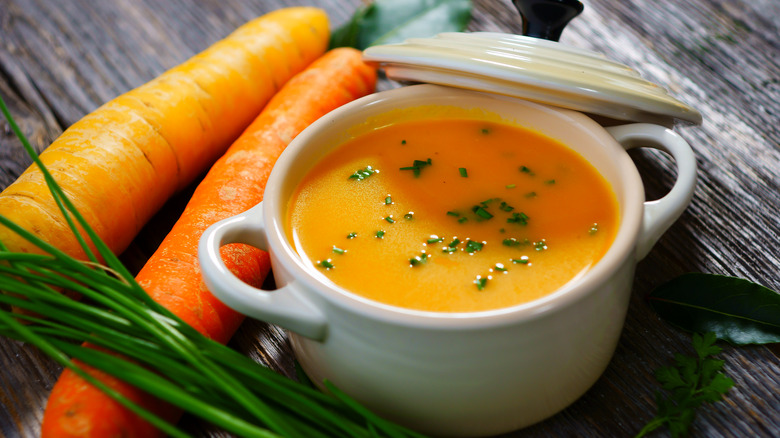How To Store Baby Carrots To Keep Them Crunchy For Weeks
A bag of baby carrots all too often becomes forgotten in the depths of the crisper drawer. Sadly, By the time the craving strikes, you may find either a slimy mess or dried-out chunks. Baby carrots should be crisp and firm, and storing them in the bag they come in — especially if it has already been opened — increases your chances of creating the aforementioned disappointment.
Instead, give the carrots a rinse and then transfer them to an airtight container. Cover them with cold, filtered water before sealing the lid. This will keep them moisturized, crunchy, and safe to eat for up to three to four weeks. Just replace the water every four to five days (or as soon as the water starts to look cloudy) to mitigate the growth of bacteria, and give them another rinse before serving. Another option is to store them wrapped in a damp paper towel, which you should also change out periodically.
Carrots have a tendency to dry out
Carrots are particularly susceptible to dehydration – whether stored in the fridge or at room temperature. Packaging in plastic bags or airtight containers helps this, as does the water packing that is best for baby carrots. Also, refrigerators create a dry environment that can make carrots go bad more quickly (though the cool temperatures do help maintain freshness).
Baby carrots also have the added disadvantage of being skinless. You might not know that baby carrots are usually just pieces of whole carrots that have been peeled and shaved down. That outer skin would otherwise offer a protective layer that helps lock moisture into the vegetable.
The main enemy of the carrot crunch you crave is air exposure, which makes them prone to turning limp, soft, shriveled, and powdery white. The white blush on baby carrots really means that they are just dry. All carrots need moisture to maintain their crunch, so storing them in water or a wet towel is the best way to make sure they stay hydrated. For that reason, you can apply this hack to carrots you cut yourself or even whole carrots of any size. If necessary, remove carrot tops as they also will draw out moisture from the vegetable, and wash the roots well before storing them in a sealed container with water.
What is the carrot Plan B?
While this method is your best bet at keeping carrots fresh, it is not foolproof. Keep an eye out for mold and any off smells or textures. If they turn slimy, that can be an indication that they are no longer good to eat.
Maybe you forgot to transfer the baby carrots from the bag after you grabbed a few for an on-the-go snack, and now you don't know what to do with what's left. If the carrots show no signs of spoilage and the ice bath hack didn't bring them back to life, there are still plenty of ways to use them.
Opt for preparations that do not rely on that crunchy, water-rich texture, like purees and mashes. Roast or boil the carrots, and pair them with similarly textured vegetables like potatoes, sweet potatoes, rutabaga, turnips, radishes, and winter squash. Additions of butter, cream, or flavorful stocks add depth and replace any lost moisture. Soups are also an ideal way to use floppy carrots since they will get softened anyway. Give those sad little guys new life with this comforting and creamy carrot ginger soup with star anise recipe.
You can pop them in the freezer to use in future stews and braises. Blanching them first helps to retain more nutrients, color, and flavor. Frozen carrots also make great additions to smoothies for a veggie boost. Cooking them down or blitzing them well will completely mask any shortcomings in texture.



